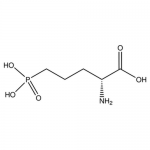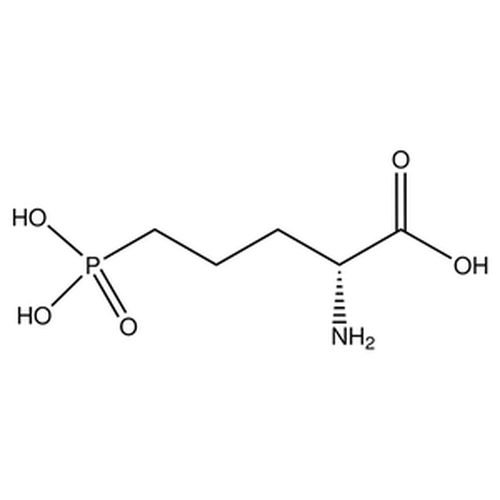| Product Name | D-AP5 |
| Description |
NMDA receptor antagonist |
| Purity | >99.5 |
| CAS No. | 79055-68-8 |
| Molecular Formula | C5H12NO5P |
| Molecular Weight | 197.13 |
| Field of Use | Not for use in humans. Not for use in diagnostics or therapeutics. For in vitro research use only. |
Properties
| Storage Temperature | -20ºC |
| Shipping Temperature | Shipped Ambient |
| Product Type | Antagonist |
| Solubility | Soluble in 100 mM water |
| Source | Synthetic |
| Appearance | White solid |
| SMILES | [C@@H]([NH3+])(CCC[P]([O-])([O-])=O)C([O-])=O |
| InChI | InChI=1S/C5H12NO5P/c6-4(5(7)8)2-1-3-12(9,10)11/h4H,1-3,6H2,(H,7,8)(H2,9,10,11)/t4-/m1/s1 |
| InChIKey | VOROEQBFPPIACJ-SCSAIBSYSA-N |
| Safety Phrases |
Classification: D2B Toxic Material Causing Other Toxic Effects, Moderate skin irritant, Moderate respiratory irritant, Moderate eye irritant Safety Phrases: S22 - Do not breathe dust. S24/25 - Avoid contact with skin and eyes. S36/37/39 - Wear suitable protective clothing, gloves and eye/face protection. Hazard statements: H315 Causes skin irritation. H319 Causes serious eye irritation. H335 May cause respiratory irritation. Precautionary statements: P261 Avoid breathing dust/ fume/ gas/ mist/ vapours/ spray. P264 Wash skin thoroughly after handling. P271 Use only outdoors or in a well-ventilated area. P280 Wear protective gloves/ eye protection/ face protection. P302 + P352 IF ON SKIN: Wash with plenty of soap and water. P304 + P340 IF INHALED: Remove victim to fresh air and keep at rest in a position comfortable for breathing. P305 + P351 + P338 IF IN EYES: Rinse cautiously with water for several minutes. Remove contact lenses, if present and easy to do. Continue rinsing. |
| Cite This Product | D-AP5 (StressMarq Biosciences Inc., Victoria BC CANADA, Catalog # SIH-411) |
Biological Description
| Alternative Names | D-amino-5-phosphonopentaoic acid |
| Research Areas | Glutamate Receptors, Ion Channels, Neuroscience, Neurotransmitter Receptors, NMDA Receptors |
| PubChem ID | 135342 |
| Scientific Background | DAP5 is used widely as a potent and selective NMDA receptor antagonist. It represents the active enantiomer form of AP5 (2-amino-5-phosphonopentanoic acid). |
| References |
1. Davies J., & Watkins J. (1982) Brain Res. 378-86. 2. Schulte M., Roon R., Chalmers D., Sunter D., & Koerner J. (1994) Brain Res. 203-7. |



Reviews
There are no reviews yet.